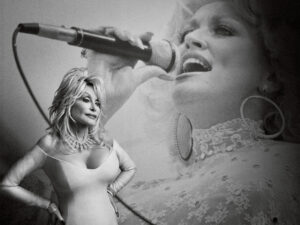“The Grit and Glory of Dolly Parton” by Emily Lordi
By Photographs by
Nov. 30, 2020
More than 50 years into her legendary career, she’s still capturing America’s particular mythology — its dreams and its disappointments — like no other.

IN JUNE OF 1967, Dolly Parton sat down for an interview with a Nashville writer named Everett Corbin. Parton was 21, and had yet to release her first solo album, but the surviving audio recording reveals that she was already shaping her account of herself with the editorial finesse of a one-woman P.R. firm: “I was born — we’ll start with when I was born, OK? — I was born on January the 19th, in 1946, in Sevier County, in Sevierville, Tenn. It’s a little town between Knoxville, Tenn., and Gatlinburg, Tenn. And you might shorten it by saying, ‘the foothills of the Great Smoky Mountains.’” Parton dutifully answers Corbin’s questions (telling him she most enjoys writing and singing “real strong, pitiful, sad, crying ballads”), before steering the conversation toward a topic he hasn’t asked about, but should have: “Well, I have a new album out, I didn’t mention — or it’s not out, but … it should be out by the end of this month. But it’s called ‘Hello, I’m Dolly.’”
In the 53 years since this auspicious exchange, Parton, who is now 74, has remained a bright star in the cosmos of culture not by reinventing herself — the term doesn’t fit a figure so beloved for her constancy, her philanthropic and rhetorical commitment to home, and to the surgical preservation of her beauty — but by strategically reintroducing herself to fans both old and new. Hello, I’m Dolly, she says repeatedly, through mutually reinforcing media platforms of musicals, films, TV shows, theme parks and books. (Her 1994 memoir, “Dolly: My Life and Other Unfinished Business,” opens with a self-mythologizing echo of her interview with Corbin: “Once upon a time and far, far away, back in the hollers at the foothills of the Great Smoky Mountains. …”) Same old me, but now I’m in the movies, she implied when moving from country music to Hollywood via the 1980 working women’s comedy “9 to 5.” Even Parton’s transition from commercial pop to folksy bluegrass in the late 1990s was framed not as a detour but as a return: These are my musical roots.
Click here to read full article